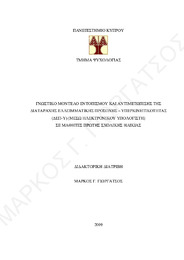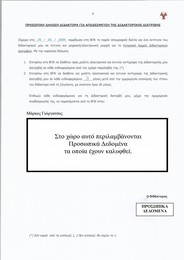| dc.contributor.advisor | Παπαδόπουλος, Τιμόθεος | el |
| dc.contributor.author | Γιώργατσος, Μάρκος Γ. | el |
| dc.coverage.spatial | Κύπρος | el |
| dc.coverage.spatial | Cyprus | en |
| dc.creator | Γιώργατσος, Μάρκος Γ. | el |
| dc.date.accessioned | 2012-09-21T07:35:43Z | |
| dc.date.accessioned | 2017-08-03T10:42:47Z | |
| dc.date.available | 2012-09-21T07:35:43Z | |
| dc.date.available | 2017-08-03T10:42:47Z | |
| dc.date.issued | 2009-05 | |
| dc.date.submitted | 2009-05-29 | |
| dc.identifier.isbn | 9789963689019, σκληρόδ. | el |
| dc.identifier.uri | https://gnosis.library.ucy.ac.cy/handle/7/39534 | en |
| dc.description | Περιέχει βιβλιογραφία (σ. 185-206). | el |
| dc.description | Αριθμός δεδηλωμένων πηγών στη βιβλιογραφία: 260 | el |
| dc.description | Διατριβή (διδακτορική) -- Πανεπιστήμιο Κύπρου, Σχολή Κοινωνικών Επιστημών και Επιστημών Αγωγής, Τμήμα Ψυχολογίας, Ιούνιος 2009. | el |
| dc.description | Η βιβλιοθήκη διαθέτει αντίτυπο της διατριβής σε έντυπη μορφή. | el |
| dc.description.abstract | Αναπτύχθηκε και εφαρμόστηκε ένα ηλεκτρονικό Γνωστικό Θεραπευτικό Πρόγραμμα (ΓΘΠ) για την αντιμετώπιση της ΔΕΠ-Υ. Η ανάπτυξη του ΓΘΠ στηρίχθηκε στις τέσσερις εκτελεστικές λειτουργίες (αναστολή, προσοχή, εργαζόμενη μνήμη και προγραμματισμός), των οποίων η δυσλειτουργία συνδέεται καθοριστικά με τη ΔΕΠ-Υ και οι οποίες, αποτέλεσαν τις τέσσερις βασικές εξαρτημένες μεταβλητές της παρούσας έρευνας. Το θεωρητικό πλαίσιο δομήθηκε από τη λεπτομερή ανάλυση και σύνθεση των τριών διαφορετικών θεωρητικών μοντέλων για τη ΔΕΠ-Υ, των Quay (1988), Cowan (1995) και Barkley (1997). Η εφαρμογή του προγράμματος ήταν βραχύχρονη (25 ατομικές συναντήσεις των 40 λεπτών), στη βάση πρώιμης παρέμβασης σε παιδιά ηλικίας 6 και 7 χρονών. Το ΓΘΠ περιλάμβανε 14 διαφορετικές ηλεκτρονικές δραστηριότητες με διαφορετικά επίπεδα δυσκολίας και 15 περίπου ασκήσεις ανά επίπεδο, στοχεύοντας στη βελτίωση της αναστολής, της προσοχής, της εργαζόμενης μνήμης και του προγραμματισμού. Από ένα αρχικό δείγμα 797 παιδιών της Α΄ Δημοτικού, καταρτίστηκαν τέσσερις τελικές ομάδες με 15 παιδιά η καθεμιά, (ΔΕΠΥ-ΜΘ= έλαβαν θεραπεία), (ΔΕΠΥ-ΧΘ= δεν έλαβαν θεραπεία), (Τυπικά Αναπτυσσόμενα Παιδιά -ΤΑΠ-ΜΘ= έλαβαν θεραπεία), (ΤΑΠ-ΧΘ= δεν έλαβαν θεραπεία). Για τον έλεγχο της αποτελεσματικότητας του ΗΓΘΠ, οι τέσσερις ομάδες αξιολογήθηκαν τρεις φορές: (α) προ-πειραματική αξιολόγηση, (β) μετα-πειραματική και (γ) μεταμέτρηση, 6 μήνες μετά την εφαρμογή του προγράμματος. Τα στατιστικά αποτελέσματα (μέσω MANOVA-MANCOVA-Repeated Measures ANOVA), έδειξαν τη βραχυπρόθεσμη και μακροπρόθεσμη αποτελεσματικότητα του προγράμματος. Οι ομάδες ΔΕΠΥ-ΜΘ και ΤΑΠ-ΜΘ που συμμετείχαν στο ΗΓΘΠ σε σύγκριση με τις ομάδες που δε συμμετείχαν σε αυτό, βελτίωσαν σε επίπεδο στατιστικής σημαντικότητας τις δεξιότητές τους στην προσοχή, αναστολή, εργαζόμενη μνήμη, προγραμματισμό, καθώς και τη σχολική τους επίδοση. | el |
| dc.description.abstract | A Computerized Cognitive Remediation (CCP) was developed and applied in children exhibiting ADHD at 6 and 7 years of age. The CCP program was designed to include four aspects of executive functions (inhibition, attention, working memory, and planning), as all four components have been determinedly connected with the etiology of ADHD. The theoretical frame of the experiment was structured by a detailed analysis and composition of three different theoretical models that have been proposed as possible explanations for inattention and disinhibition, namely, Quay’s behavioral inhibition system (1988), Cowan’s attention and working memory model (1995) and Barkley’s hybrid model (1997). The program was short in duration and intensive in application (25 sessions, 40 minutes each), and its design relied extensively on recent findings from early intervention studies in learning disabilities. The CCP included 14 different computerized activities, each having a number of different levels of difficulty and an approximate number of 15 items per level, aiming to improve the inhibitory mechanisms, attention, working memory and the planning processes of children exhibiting attention deficits. The original group of this large scale study consisted of 797 Grade 1 children randomly chosen from public schools in Cyprus. From this sample, four groups were formed, each having 15 children that were equivalent on age, gender, and parental education: (a) ADHD-R= Remediated), (b) ADHD-NR=Non-Remediated, (c) TDC-TR= Typically Developing Children-Remediated, (d) TDC-NR= Non-Remediated. To test the effectiveness of CCP, the four groups were assessed three times: (a) at the second term of Grade 1 (pre-test assessment), (b) immediately after remediation (post-test assessment) and (c) in Grade 2 (follow-up assessment). MAN(C)OVA Repeated Measures analysis showed that the remediated groups improved significantly more than the non-remediated groups in almost all the dependent measures of the study as well as on school achievement (as measured in Language Arts and Math) at both post-test and follow-up assessments. Similarly, teacher ratings improved significantly for the ADHD remediated group compared to the non-remediated counterparts. Discussion focuses on the need for devising remedial schemes that will be both theoretically driven and cost-effective, leading, consequently, to substantial improvements in attention and executive functioning early interventions. | en |
| dc.format.extent | xiv, 241 σ. : εικ. (μερ. έγχρ.), πίν. ; 30 εκ. | el |
| dc.language.iso | gre | en |
| dc.publisher | Πανεπιστήμιο Κύπρου, Σχολή Κοινωνικών Επιστημών και Επιστημών Αγωγής / University of Cyprus, Faculty of Social Sciences and Education | |
| dc.rights | info:eu-repo/semantics/openAccess | en |
| dc.rights | Open Access | en |
| dc.subject.lcsh | Attention | en |
| dc.subject.lcsh | Diagnosis | en |
| dc.subject.lcsh | Inhibition | en |
| dc.subject.lcsh | Inhibition (Psychology) | en |
| dc.subject.lcsh | Memory in children | en |
| dc.subject.lcsh | Memory, Psychological aspects | en |
| dc.subject.lcsh | Planning | en |
| dc.subject.lcsh | Planning in children | en |
| dc.subject.lcsh | Short-term memory | en |
| dc.title | Γνωστικό μοντέλο εντοπισμού και αντιμετώπισης της διαταραχής ελλειμματικής προσοχής - υπερκινητικότητας (ΔΕΠ-Υ) (μέσω ηλεκτρονικού υπολογιστή) σε μαθητές πρώτης σχολικής ηλικίας | el |
| dc.type | info:eu-repo/semantics/doctoralThesis | en |
| dc.contributor.committeemember | Παπαδόπουλος, Τιμόθεος | el |
| dc.contributor.committeemember | Διακίδου, Ειρήνη-Άννα | el |
| dc.contributor.committeemember | Παναγιώτου, Γεωργία | el |
| dc.contributor.committeemember | Ζώνιου - Σιδέρη, Αθηνά | el |
| dc.contributor.committeemember | Δαβάζογλου, Αγγελική | el |
| dc.contributor.committeemember | Papadopoulos, Timotheos | en |
| dc.contributor.committeemember | Diakidoy, Ireni-Anna | en |
| dc.contributor.committeemember | Panayiotou, Georgia | en |
| dc.contributor.committeemember | Zoniou - Sideri, Athena | en |
| dc.contributor.committeemember | Diavazoglou, Aggeliki | en |
| dc.contributor.department | Πανεπιστήμιο Κύπρου, Σχολή Κοινωνικών Επιστημών και Επιστημών Αγωγής, Τμήμα Ψυχολογίας | el |
| dc.contributor.department | University of Cyprus, Faculty of Social Sciences and Education, Department of Psychology | en |
| dc.subject.uncontrolledterm | ΑΝΙΧΝΕΥΣΗ | el |
| dc.subject.uncontrolledterm | ΑΝΑΣΤΟΛΗ | el |
| dc.subject.uncontrolledterm | ΠΡΟΣΟΧΗ | el |
| dc.subject.uncontrolledterm | ΕΡΓΑΖΟΜΕΝΗ ΜΝΗΜΗ | el |
| dc.subject.uncontrolledterm | ΠΡΟΓΡΑΜΜΑΤΙΣΜΟΣ | el |
| dc.subject.uncontrolledterm | ΔΙΑΓΝΩΣΗ | el |
| dc.subject.uncontrolledterm | ΑΝΤΙΜΕΤΩΠΙΣΗ - ΘΕΡΑΠΕΙΑ | el |
| dc.subject.uncontrolledterm | ΕΚΤΕΛΕΣΤΙΚΕΣ ΛΕΙΤΟΥΡΓΙΕΣ | el |
| dc.subject.uncontrolledterm | MEMORY | en |
| dc.subject.uncontrolledterm | SCREENING | en |
| dc.subject.uncontrolledterm | WORKING MEMORY | en |
| dc.subject.uncontrolledterm | REMEDIATION - THERAPY | en |
| dc.subject.uncontrolledterm | EXECUTIVE FUNCTIONS | en |
| dc.identifier.lc | BF321.G56 2009 | en |
| dc.author.faculty | Σχολή Κοινωνικών Επιστημών και Επιστημών Αγωγής / Faculty of Social Sciences and Education | |
| dc.author.department | Τμήμα Ψυχολογίας / Department of Psychology | |
| dc.type.uhtype | Doctoral Thesis | en |
| dc.rights.embargodate | 2009-08-29 | |
| dc.contributor.orcid | Παπαδόπουλος, Τιμόθεος [0000-0002-5541-568X] | |


